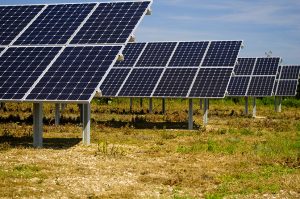SynTerra authors shed light on use of mined mountaintops to farm solar energy.

The roadmap to solar energy in Central Appalachia presents several obstacles, including a lack of economic incentive for utilities and other land owners. The terrain — filled with steep slopes and narrow valleys — is another obstacle, but there are mined mountaintop locations where the sun could do its thing.
Posted July 18, 2019:
Solar energy and Central Appalachia are not usually mentioned in the same conversation. There are myriad reasons, including: incompatible terrain; absence of federal and state policies/incentives that promote solar energy; and lack of incentive for utility companies, land owners, and mining companies. SynTerra research and analysis, however, indicate that the solar energy situation could change in Central Appalachia — if attitudes change and minds are open to a novel approach: using the locations of previous mountaintop mine sites for solar energy projects.
Five SynTerra professionals — Al Campoli, Steve Gardner, Doug Mynear, Andy Willis, and Seth Mittle — took a months-long deep dive into Central Appalachia’s solar energy landscape (pun intended). They presented their observations and recommendations in “Adaptive reuse of mined lands for solar energy,” published in the June 2019 edition of Mining Engineering Magazine, the technical journal of the Society for Mining, Metallurgy and Exploration. The authors, each with decades of experience in the mining industry, began their project as leaders and employees of ECSI. (Lexington, KY-based ECSI became part of SynTerra in January 2019.)
The project was launched when a nonprofit organization asked ECSI to produce a roadmap to solar energy in Central Appalachia. The ECSI/SynTerra team accepted the challenge knowing that any such roadmap wouldn’t be smoothly paved. An analysis of inconsistent federal solar policies strengthened that realization, and an analysis of state solar policies drove it home poignantly. In addition to a lack of support for getting projects started, there is not always a clear pathway to selling electricity from solar projects.
The authors contend that pressure to enact any legislative changes will have to come from outside of the state government. Outside pressure could come from a combination of entities, including utility companies, large corporations, large landholding companies, and the public. Those same entities could also provide the impetus and framework for facilitating the actual sale of electricity generated by solar energy projects.
The SynTerra project addresses the challenge of available land. Central Appalachia is full of steep slopes and narrow valleys, neither of which allows the sunlight necessary for solar energy project success. This is where the novel approach — and unlikely teaming of mining and solar energy industries — comes into play. The viable solution is the use of mined mountaintops for solar panels. There are plenty of the mountaintop locations, and there are no slopes or valleys in play; the sun can do its thing.
Yes, there are accessibility issues, and there are the legislative/policy hurdles, but if attitudes change and sensibility prevails, it will be more than doable to place solar panels on mined mountaintops. Potential rewards include:
- Continued (and profitable) use of land for mine companies and other property owners
- Economic incentives in the forms of new revenue streams and rapid bond releases for reclamation
- Job creation in areas of comparatively high unemployment and lack of employment
- A reduced carbon footprint as the solar alternative replaces other energy-producing methods
Read the full article: “Adaptive reuse of mined lands for solar energy”





